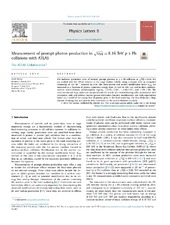Measurement of prompt photon production in √sNN = 8.16 TeV p + Pb collisions with ATLAS
Aaboud, Morad; Aad, Georges; Abbott, Brad; Abbott, Dale C.; Abdinov, Ovsat Bahram oglu; Abeloos, Baptiste; Abhayasinghe, Deshan Kavishka; Abidi, Syed Haider; AbouZeid, Hass; Abraham, Nadine L.; Buanes, Trygve; Djuvsland, Julia Isabell; Eigen, Gerald; Fomin, Nikolai; Lipniacka, Anna; Martin dit Latour, Bertrand; Mæland, Steffen; Stugu, Bjarne; Yang, Zongchang; Bugge, Magnar Kopangen; Cameron, David Gordon; Catmore, James Richard; Feigl, Simon; Garonne, Vincent; Gramstad, Eirik; Hellesund, Simen; Morisbak, Vanja; Oppen, Henrik; Ould-Saada, Farid; Pedersen, Maiken; Read, Alexander Lincoln; Røhne, Ole Myren; Sandaker, Heidi; Serfon, Cédric; Vadla, Knut Oddvar Høie; Abramowicz, Halina; Abreu, Henso; Abulaiti, Yiming; Acharya, Bobby S.; Adachi, Shunsuke; Adam, Lennart; Adamczyk, Leszek; Adamek, Lukas; Adelman, Jareed; Adersberger, Michael; Adigüzel, Aytül; Adye, Tim; Affolder, Anthony Allen; Afik, Yoav; Agheorghiesei, Catalin; ATLAS, Collaboration
Peer reviewed, Journal article
Published version

Åpne
Permanent lenke
https://hdl.handle.net/1956/22816Utgivelsesdato
2019Metadata
Vis full innførselSamlinger
Originalversjon
https://doi.org/10.1016/j.physletb.2019.07.031Sammendrag
The inclusive production rates of isolated, prompt photons in p + Pb collisions at √sNN = 8.16 TeV are studied with the ATLAS detector at the Large Hadron Collider using a dataset with an integrated luminosity of 165 nb−1 recorded in 2016. The cross-section and nuclear modification factor RpPb are measured as a function of photon transverse energy from 20 GeV to 550 GeV and in three nucleon– nucleon centre-of-mass pseudorapidity regions, (−2.83,−2.02), (−1.84, 0.91), and (1.09, 1.90). The cross-section and RpPb values are compared with the results of a next-to-leading-order perturbative QCD calculation, with and without nuclear parton distribution function modifications, and with expectations based on a model of the energy loss of partons prior to the hard scattering. The data disfavour a large amount of energy loss and provide new constraints on the parton densities in nuclei.
